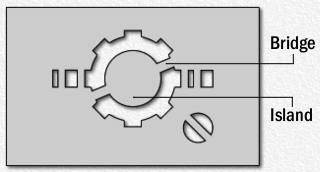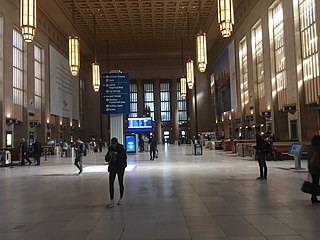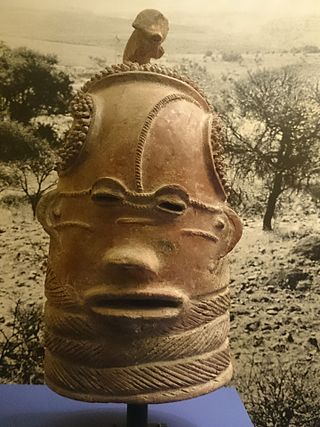Ndebele house painting is a style of African art practiced by the Southern Ndebele people of South Africa and the Northern Ndebele people in Zimbabwe in Matobo. [1] It is predominantly practiced by the Ndebele women.
Ndebele house painting is a style of African art practiced by the Southern Ndebele people of South Africa and the Northern Ndebele people in Zimbabwe in Matobo. [1] It is predominantly practiced by the Ndebele women.
The art found in the traditional homestead of the Ndebele people dates back to a thousand years and is evidenced by the rock art found in the Matopos [2] [3] attributed to the Khoi-San. [4] [1] [5] In 2016 the US Ambassador's' fund for Cultural preservation (AFCP) [6] awarded a grant to document the Ndebele traditional art form of hut painting and decoration. This comes as it is important to pass on the skills and knowledge from one generation to the other. [1]
During the 18th century, the Ndzundza Ndebele people of South Africa created their tradition and style of house painting. Until the late 1900s, the Ndebele noted warriors and large landowners. In the autumn of 1883, they went to war with the neighboring Boers. The loss of the war brought on a harsh life and horrible punishments for the Ndebele. Through those hard times, expressive symbols were generated by the suffering people expressing their grief. These symbols were the beginning of the African art form. [7]
The Ndebele tribe originally in the early 18th century lived in grass huts. They began using mud-walled houses in the mid-18th century when these symbols begin to be created on their houses and walls. These expressive symbols were used for communication between sub-groups of the Ndebele people. They stood for their continuity and cultural resistance to their circumstances. The Boer farmers did not understand the meaning and viewed it as cultural art that was not harmful, so it was allowed to continue. These wall paintings done by the women were their secret code to their people, disguised to anyone but the Ndebele. [8]
The vibrant symbols and expressions portray communications of personal prayers, self-identification, values, emotions, and marriage. Sometimes the male initiation, known as UkuWela (The Crossing), was a reason for repainting, but the ritual was not expressed. One quality of life that has never been expressed or directed through their walls is sacred expression. The rituals and religions have never been a part of the Ndebele's house paintings. The women of the Ndebele are often the traditional carriers and the main developer of the wall art of their home. The tradition and style of house painting are passed down in the families from generation to generation by the mothers. A well-painted home shows the female of the household as a good wife and mother. She is responsible for the painting of the outside gates, front walls, side walls, and usually the interior of her home. One thing that has changed since the beginning of house painting and present-day wall art is their styles.[ citation needed ]
At the beginning of house painting, their symbols and patterns were often based on Ndebele's beadwork. The patterns were tonal and painted with the women's fingers. The original paint on the house was a limestone whitewash. The colors added to make the paintings were mostly natural pigments consisting of browns, blacks, and others. Most of the patterns were of a V shape and a very simple triangle on a large shape color. The patterns, earth tones, directions, and sizes were more important than the present-day vivid and bright colors.[ citation needed ]
Over time, the colors and shape became a key aspect of the overall design. In the late 1968s, the new style was evident. What was once a finger-painted creation was now created using bundled twigs with feathers as brushes. The walls are still originally whitewashed, but the outlines and colors have significantly changed. The patterns and symbols can be seen today with a rich black outline and a vivid color inside. There are five main colors represented: red and dark red, yellow to gold, sky blue, green, and sometimes pink. The colors give an intensified symbolic meaning to the Ndebele. They can mean the status or power of the home's owners, offer prayer, announce a marriage in the home, or can represent a current protest. The paintings express an abstract meaning with no real. This is the most direct way to show their expression to the people outside their far distinct family, showing the talent and the taste of the mother. The color white is always used as the background because it makes the bright patterns stand out more. [1]
The pink patterns are one of the most important aspects of their communication through painting. They are usually repeated throughout their design with only a very slight variation and different color choices. The geometric patterns and shapes are first drawn with the black outline and later filled in with color. The patterns are grouped throughout the walls in terms of their basic design structure. Creating the right tools to allow accuracy and freedom become a difficult task. The tools can't restrict the painter from creating her art. They have to have tools for the large geometric shapes of flat color and small brushes for the very small areas, outlines, and sacks. The advancement of tools has allowed faster and more complex designs throughout the Ndebele's homes. [1]
These very simple-looking painted houses are a complex system of tradition and creation. This painted tradition is still alive today. As every generation passes it down little changes begin to exist. This is their way of communication and expression through their home. The women work long and hard to finish these walls and are noticed by the outside community because of their talent and expression.[ citation needed ]

A quilt is a multi-layered textile, traditionally composed of two or more layers of fabric or fiber. Commonly three layers are used with a filler material. These layers traditionally include a woven cloth top, a layer of batting or wadding, and a woven back combined using the techniques of quilting. This is the process of sewing on the face of the fabric, and not just the edges, to combine the three layers together to reinforce the material. Stitching patterns can be a decorative element. A single piece of fabric can be used for the top of a quilt, but in many cases the top is created from smaller fabric pieces joined, or patchwork. The pattern and color of these pieces creates the design.

Stencilling produces an image or pattern on a surface by applying pigment to a surface through an intermediate object, with designed holes in the intermediate object. The holes allow the pigment to reach only some parts of the surface creating the design. The stencil is both the resulting image or pattern and the intermediate object; the context in which stencil is used makes clear which meaning is intended. In practice, the (object) stencil is usually a thin sheet of material, such as paper, plastic, wood or metal, with letters or a design cut from it, used to produce the letters or design on an underlying surface by applying pigment through the cut-out holes in the material.

African art describes the modern and historical paintings, sculptures, installations, and other visual culture from native or indigenous Africans and the African continent. The definition may also include the art of the African diasporas, such as: African-American, Caribbean or art in South American societies inspired by African traditions. Despite this diversity, there are unifying artistic themes present when considering the totality of the visual culture from the continent of Africa.

Clarice Cliff was an English ceramic artist and designer. Active from 1922 to 1963, Cliff became the head of the Newport Pottery factory creative department.

Interior design is the art and science of enhancing the interior of a building to achieve a healthier and more aesthetically pleasing environment for the people using the space. With a keen eye for detail and a creative flair, An interior designer is someone who plans, researches, coordinates, and manages such enhancement projects. Interior design is a multifaceted profession that includes conceptual development, space planning, site inspections, programming, research, communicating with the stakeholders of a project, construction management, and execution of the design.

Rangoli is an art form that originates from the Indian subcontinent, in which patterns are created on the floor or a tabletop using materials such as powdered lime stone, red ochre, dry rice flour, coloured sand, quartz powder, flower petals, and coloured rocks. It is an everyday practice in many Hindu households, however making it is mostly reserved for festivals and other important celebrations as it is time-consuming. Rangolis are usually made during Diwali or Tihar, Onam, Pongal, and other Hindu festivals in the Indian subcontinent, and are most often made during Diwali. Designs are passed from one generation to the next, keeping both the art form and the tradition alive.

Color field painting is a style of abstract painting that emerged in New York City during the 1940s and 1950s. It was inspired by European modernism and closely related to abstract expressionism, while many of its notable early proponents were among the pioneering abstract expressionists. Color field is characterized primarily by large fields of flat, solid color spread across or stained into the canvas creating areas of unbroken surface and a flat picture plane. The movement places less emphasis on gesture, brushstrokes and action in favor of an overall consistency of form and process. In color field painting "color is freed from objective context and becomes the subject in itself."

The Matobo National Park forms the core of the Matobo or Matopos Hills, an area of granite kopjes and wooded valleys commencing some 35 kilometres (22 mi) south of Bulawayo, southern Zimbabwe. The hills were formed over 2 billion years ago with granite being forced to the surface; it has eroded to produce smooth "whaleback dwalas" and broken kopjes, strewn with boulders and interspersed with thickets of vegetation. Matopo/Matob was named by the Lozwi, who are the ancestors of Kalanga. A different tradition states that the first King, Mzilikazi Khumalo when told by the local residents that the great granite domes were called madombo he replied, possible half jest, "We will call them matobo" - an IsiNdebele play on 'Bald heads'.

Korean embroidery techniques and artifacts have a long history, but there is the most evidence from the Joseon Dynasty, after the 14th century in Korea. This article talks about the history, styles, preservation, artists, and examples of screens, costumes, and domestic wares of this exacting and beautiful art form.

Madhubani art is a style of painting practiced in the Mithila region of India and Nepal. It is named after the Madhubani district of Bihar, India, which is where it originated. Jitwarpur and Ranti are the two most notable cities associated with the tradition and evolution of Madhubani art. The art was traditionally practiced by female members of Brahman and Kayastha castes. Artists create these paintings using a variety of mediums, including their own fingers, or twigs, brushes, nib-pens, and matchsticks. The paint is created using natural dyes and pigments. The paintings are characterized by their eye-catching geometrical patterns. There is ritual content for particular occasions, such as birth or marriage, and festivals, such as Holi, Surya Shasti, Kali Puja, Upanayana, and Durga Puja.
Painting – artwork in which paint or other medium has been applied to a surface, and in which area and composition are two primary considerations.

Alma Woodsey Thomas was an African-American artist and teacher who lived and worked in Washington, D.C., and is now recognized as a major American painter of the 20th century. Thomas is best known for the "exuberant", colorful, abstract paintings that she created after her retirement from a 35-year career teaching art at Washington's Shaw Junior High School.

South African Bantu-speaking peoples represent the majority ethno-racial group of South Africans. Occasionally grouped as Bantu, the term itself is derived from the English word "people", common to many of the Bantu languages. The Oxford Dictionary of South African English describes "Bantu", when used in a contemporary usage or racial context as "obsolescent and offensive", because of its strong association with the "white minority rule" with their Apartheid system. However, Bantu is used without pejorative connotations in other parts of Africa and is still used in South Africa as the group term for the language family.
Uli (Uri) are the curvilinear traditional designs drawn by the Igbo people of southeastern Nigeria. These designs are generally abstract, consisting of linear forms and geometric shapes, though there are some representational elements. Traditionally, these are either stained onto the body or painted onto the sides of buildings as murals. Designs are frequently asymmetrical and are often painted spontaneously. Uli is generally not sacred, apart from those images painted on the walls of shrines and created in conjunction with some community rituals. In addition, uli is not directly symbolic but instead focused on the creation of a visual impact and decorating the body of the patron or building in question.

The Afrika-Haus Freiberg is a museum of modern African art at Freiberg am Neckar in Germany.

Esther Mahlangu is a South African artist. She is known for her bold large-scale contemporary paintings that reference her Ndebele heritage. She is one of South Africa's best known artists.
Mwari also known as Musikavanhu, Musiki, Tenzi and Ishe, is the Supreme Creator deity according to Shona traditional religion. It is believed that Mwari is the author of all things and all life and all is in him. The majority of this deity's followers are concentrated in Mozambique, South Africa, and Zimbabwe. Mwari is an omnipotent being, who rules over spirits and is the Supreme God of the religion.

Litema, spelled as Ditema in South African Sesotho orthography is a form of Sesotho mural art composed of decorative and symbolic geometric patterns, commonly associated with Sesotho tradition today practised in Lesotho and neighbouring areas of South Africa. Basotho women generate litema on the outer walls and inside of homesteads by means of engraving, painting, relief mouldings and/or mosaic. Typically the geometric patterns are combed or scratched into the wet top layer of fresh clay and dung plaster of the wall, and later painted with earth ochers or, in contemporary times, manufactured paint. Patterns most often mimic ploughed fields through a combed texture, or the patterns refer to plant life, and more occasionally to other aspects of the natural world, such as referring to clan totem animal. Litema are transient; they may desiccate and crumble or be washed away by heavy rain. It is common for women of an entire village to apply litema on such special occasions as a wedding or a religious ceremony.

Chowk-poorana or Chowkpurana is folk art practised in Punjab, Haryana, Himachal Pradesh, Madhya Pradesh and Uttar Pradesh. In Uttar Pradesh, the term chowk-poorana refers to decorating the floor with various designs using flour and rice and also the walls using designs specific to the region.
Bihar is a state in eastern India divided by the Ganges river, an area which was once an important center for culture and learning. A Neolithic settlement has been discovered at Chirand which contains rock paintings similar to those found in Spain's Altamira and France's Lascaux regions. The tradition of painting has been handed down from generation to generation in the families of the Mithila and Bhojpur regions mainly by women. Painting was usually done on walls during festivals, religious events, and other milestones of the life cycle, like birth, Upanayanam, and marriage. Other styles of this region include Tikuli, Manjusha, and Patna kalam.